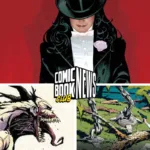You all probably know the story of the Salem Witch Trials. Young girls started showing signs of being manipulated by witchcraft. That led to multiple hangings and killings. And ultimately whether it was a prank gone wrong, mass hysteria, or something else is still not known. That’s something writer Deborah Noyes is digging deeper into with her new graphic novel, An Outbreak of Witchcraft.
“I think we understand today that history is often written by those in power, with the powerless denied a voice, a chance to tell their own story,” Noyes told Comic Book Club. “While historians may never reach consensus on what happened in Salem, the trial transcripts contain many voices—not just the voices of legal judgment and (later) revocation.”
As indicated above, Noyes went back to the original voices to try and present the story in a more factual and rounded manner. Though thanks to Noyes’s storytelling, and artist M. Duffy’s craft, what you’re left with is a tragedy all around.
To find out more about the book, which hits stores tomorrow (June 4) from Little, Brown Ink, read on.
Comic Book Club: You talk about this in the book, but why do you think there’s a continued fascination with the Salem Witch Trials?
Deborah Noyes: I’ll argue the “unsolved mystery” aspect—and the sheer scale of what happened.
Though there are chunks of the book taken from public reports, at times you’re also taking dramatic license to show more private conversations or moments to fill in the blanks. As a biographer, how do you choose when to deviate from recorded history?
Very carefully. It can be a slippery slope. I intended this as narrative nonfiction—with a responsibility to document the truth as historians understand it. But the “narrative” part of that equation poses demands, too. Narrative equals story, and stories have structure. Truth rarely does. To do more than line up facts and dates, to narrate—with depth and flow and plausible transitions—you have to reflect on what happened between the lines, in the private lives behind the public spectacle.
I was lucky to have a rich store of primary source material to draw from, but the trials were characterized by secrecy, conspiracy, and emotional complexity. Do primary sources assure that we’re hearing the truth, the whole truth, and nothing but the truth? They allow us to form our own conclusions. But every person involved witnessed what happened through the lens of their own fear, desires, and agendas. They told the truth–if they did–as they understood it. The “whole” truth, or the closest we can come to it, is many truths distilled. It’s where the versions intersect.

Structurally, you start each part with a text section to introduce the action – why was this important?
Context is everything when you study the trials, and there’s far too much of it to include in a single storyline or endnote. The part openers were a way to provide that social context timed to the dramatic arc. It was a trade-off, in that the openers interrupt the story, but without them—with such a large cast and complicated plot—most readers would feel lost at some point. You can skim over the notes (many readers will, of course), but if you need to glance back and clarify something, you can.
As the book continues there are moments, particularly in the second half, that rely more on M. Duffy’s art. Can you talk about writing those pages? Or was it letting them do their thing?
I did include a few art notes in my script, not to be directive (yes, you absolutely trust the artist to do their thing) but to share what I was seeing in my mind’s eye as I wrote. For example, on p. 107, I saw the imprisoned Dorothy Good setting out crumbs of bread to feed the rats and draw them close. This bit of characterization wouldn’t come through in dialog, but it seemed to me what a certain kind of bored and lonely child might do in isolation. It’s a visual fiction that I hope feels emotionally true.
Some of the quieter sequences there are truly stunning and saddening – do you have a favorite, some pages you got in that just floored you?
Yes! M. Duffy is a genius with light, shadow, and subtext. My favorite panel is the last on p. 93, when Ann Putnam Jr. and Mary Warren are outside hanging laundry, and their talk turns to Mary’s abuse at the hands of her master. M. Duffy’s choice to position the girls with their backs to the viewer, veiled by transparent laundry, is poignant. It’s one of countless loaded, intimate moments of visual narrative in the book.

Given there has been so much writing and reporting on this period, were there any details in particular that surprised you?
I was struck again by the scope of what many historians call the “contagion.” I had no idea how many settlements in the colony and beyond became involved.
Completely irresponsible question you can feel free not to answer: do you have a theory as to what happened? You float “mass hysteria” towards the end there as the generally accepted answer, but do you agree?
In a way the whole book is my answer to this question (cheating, I realize, but true). The “perfect storm” theory—that there was no single cause but a fateful confluence—rings truest for me, but I find the mystery galvanizing and always have, especially the extreme physical symptoms displayed by many of the afflicted, which still feel unexplained.
Given what we’ve talked about above (and I think I know the answer to this one) but why was it important to retell the story of the Salem Witch Trials, now?
I think we understand today that history is often written by those in power, with the powerless denied a voice, a chance to tell their own story. While historians may never reach consensus on what happened in Salem, the trial transcripts contain many voices—not just the voices of legal judgment and (later) revocation. Most of this story is drawn directly from witness testimony. I urge curious readers to visit the impressive Salem Witch Trials Documentary Archive online at the University of Virginia to learn more and form their own conclusions.
An Outbreak of Witchcraft is in stores everywhere on Tuesday, June 4 from Little, Brown Ink.


Comic Book Club Live Info:
Discover more from Comic Book Club
Subscribe to get the latest posts sent to your email.










